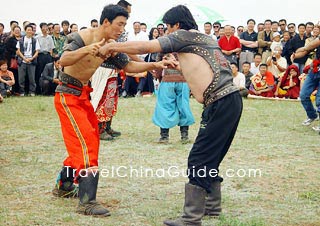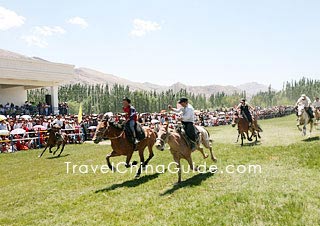Land Based Sports & Activities
Crossbow-Firing (Shenu)
Firing arrows with a crossbow is quite an old traditional land based sport that has been popular for thousands of years in ethnic groups such as Miao, Yi, Lahu, Lisu, and Yao. Miao men practice shooting with the crossbow from boyhood and contests are often held. They use corn cakes and pieces of meat as targets and players who hit these receive them as prizes. The winner with the best record usually receives other things as well as the esteem of the villagers. When they grow up and go out hunting and fishing, they will always take crossbow with them. One of the reasons for the importance of this sport is that as these people live in a mountainous area where wild and often dangerous animals are frequently encountered.
A crossbow is usually made of the tough wood of the yansang tree that grows mostly in Hunan and Guangxi Provinces. With a trigger made of cattle or goat horn, the larger bow is about 1.5 meters (4.9 feet) wide and 0.75 - 1 meter long (2.46 - 3.28 feet); and the smaller one is 1 meter (3.3 feet) wide and 0.5 - 0.7 meter (1.64 - 2.3 feet) long. The effective range of the large bow is around 200 meters (656 feet) and that of the small one is around 100 meters (328 feet). Bows may be used from either a standing or kneeling posture and it requires considerable strength to draw back the string and put the bolts or arrows in place.
Often during festivals and galas, there will be crossbow contests among people of ethnic groups. The criteria lie in the distance and the accuracy. In the China's 2nd National Games of Minority Nationality's Traditional Sports in 1982, players from Yunnan and Guangxi Province performed this sport with excellent skills, and in the 3rd games, it formed one of the main competitions.
Mongolian Wrestling (Shuaijiao)
 |
| Mongolian Wrestling on Nadam Fair |
This is Mongolian wrestling a sport loved by the Mongolian people. Before the game, a revered elder will select the pairs of contestants and take assume the role of judge. Two sides of participants will send singers to lay down a challenge. After three rounds, wrestlers make their entrance while dancing lion or eagle steps. There is no time limit in the games, either is the area, age, or weight; but the loser will not come on again. Its rules state that they are not allowed to hold the other's leg or wrestle in a kneeling posture. Any part above the knee signifies the failure. The winner will finally be declared the wrestling hero.
Besides the wonderful game itself, the dress of wrestlers is also a distinctive highlight. They will wear waistcoats made from cowhide and canvas that leave the arms bare. The waistcoats are decorated with copper or silver rivets and on the back characters indicate the wearer's prowess. Around their waists they wear aprons in red, yellow, and blue colors. The trousers are mostly white with animals and flower patterns. Finally, silk fringes adorn their necks, the number of the colored strips symbolizing their place in the competition.
Shuttlecock without Racket (Shoujian and Jianqiu)
These are games of Shuttlecock and Hand Shuttlecock. Hand shuttlecock originated from the Tang (618 - 907) and Song Dynasty (960 - 1279) and has been adopted by the Miao and Dong ethnic groups. When playing the game, Miao people hit the shuttlecock with their hands in a similar way to tennis but without rackets! The way in which the shuttlecock is made is rather special - it is held together with quality corn peel, wrapped in fine embroidery in either square or hexagonal shapes. The flight is made from three large feathers from the wings of a chicken. This sport developed from activities people engaged in while planting paddy rice.
The shuttlecock evolved from the hand shuttlecock. The playground is usually in the length of 12 meters (13 yards) and the width of 6 meters (6.5 yards), with a net in the middle. Each team has three players. They mainly play by skillful kicking. The game is similar to volleyball, but the shuttlecock may not be touched with the hands or arms. A team has to win two games out of three in a set. The first team to win 15 sets wins the match.
Horse Racing (Saima)
 |
| Horse Racing |
This is horse racing. Riding a horse is an essential part of the lifestyle of those ethnic groups of a heroic spirit, especially in the areas of Inner Mongolia, Xinjiang, Tibet, Qinghai, Gansu, Yunnan, Guizhou and Sichuan. People in those areas live mostly on the plains which provide a natural field for the races. There are regional variations and the types of competition are diverse.
The main contests involve racing, horsemanship to demonstrate the handling of the mount as well as the ability of the animal achieved through its training, shooting and throwing spears while in the saddle and picking up 'hada'; these are silk favors and an auspicious symbols of esteem for the rider. The contestants ride along a course that has two sides of over 100-meter-long (109-yards-long) along which are 10 hadas; the player has 12 seconds in which to pick them up in order to score a point. If he exceeds the time limit a point is deducted for each second. The result is decided after two rounds. Balloons are used as targets for the shooting matches and distance as well as accuracy is an element of the contest. Bamboo spears are thrown at a target set at some distance form the course.